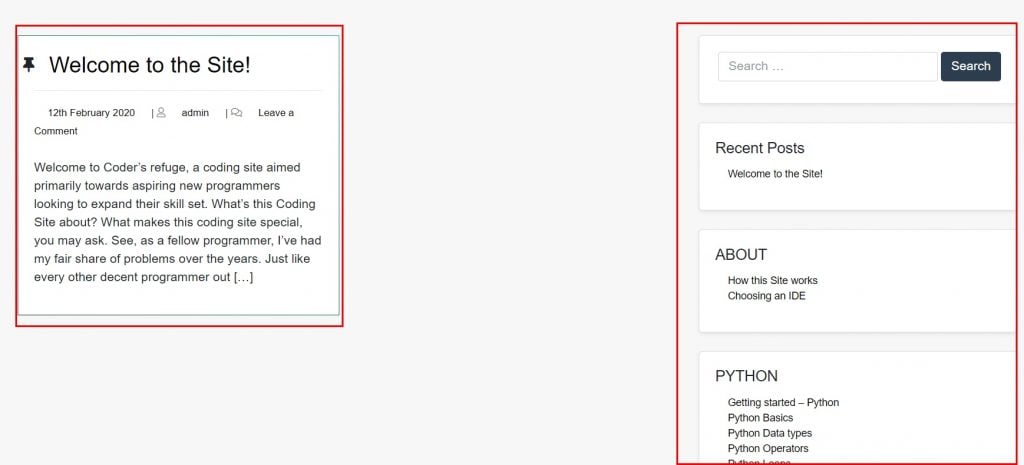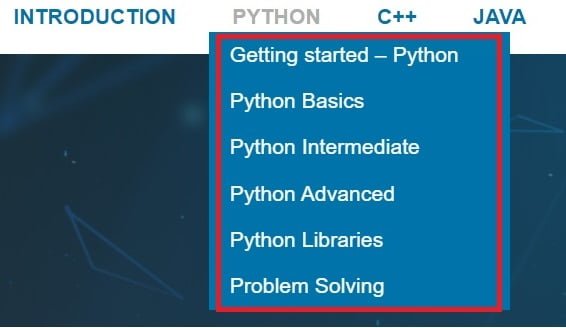We’ll be going through a detailed break down of this site and it’s individual parts. Before we begin though, I recommend you read through our welcome post which you can also find on the home page. This page will further expand on that post and outline the structure of the site.
Understanding the Structure of the Site

What’s makes a good coding site? Well, for starters, it should have a variety of programming languages available. We’ll be starting off with Python, Java, Visual Basic (VB) and C++, with the intent of adding more in the future. The Introduction section shown above has several useful Articles for new programmers and even for some experienced ones. Any confusions you may have regarding programming languages or IDE’s will be cleared away there. It’s a must read!

Let’s move on to the Home page. Our posts section is located on the Left hand side. We’ll be making a post to announce the adding of new content or for other coding related activities, so keep your eyes peeled.
On the Right hand side, is our side bar. The side bar has a complete list of all topics and sub-topics for each programming language. Other useful tools can also be found here, such as the search option, and the Recent posts section.
Understanding the Structure of the Content

Let’s get around to the main point of this post. Understanding how to navigate through the site’s content. From now on, we’ll be referring to the languages (Python, Java etc) as “Subjects”. Each subject we add, will follow a general structure. It’s going to have a “Getting Started” section, that explains how to set it up, in this case, how and where to install Python software.
Next up is our content difficulty. We sort out our content in three levels to keep things simple. The “Basics” section is for programmers new to that specific subject. Whereas Intermediate and Advanced are for those who have prior knowledge. Though even for our experienced users we recommend you take a quick look through the Basics section. Not only do we cover the basics, but we cover intuitive and out-of-the-box techniques, along with useful implementations, to help you understand it’s full potential.
Each section is further divided into sub-sections. There is no limit to the number of sub-sections that may be present. Lets take the Python Basics as an example. It is further divided into sub-sections like, Python Loops, Python Functions and more.
Note: As of March 2020, only the Basics division has been released for every subject.
That brings us to the last Page you can see, called “Problem Solving”. As we mentioned earlier in our welcome post, we aim to be showing practical implementations of what we teach. Basically, it’s going to be a collection of scenarios, each with a step-by-step breakdown on how to solve it. For example, a Scenario might be, “How to search through a hundred files and pick the ones beginning with 2020”. For those who don’t know, we’ll be using the concepts of “File Handling” and “Regex” (Non-Regex implementation will be shown as well) here. There is no limit to the number of scenarios we will be adding. Users can contribute here by coming up with the Scenario and presenting it. Contributor’s will have their names mentioned next to their provided “scenario”. Check out the Contribute page for further details.
Wrapping up
There’s one page mentioned in the image above that we didn’t talk about. The “Python Libraries” page. Now, this is a section that is mostly unique to Python due it’s extensive use of external Libraries. (Check out the Libraries page for more details) Let’s take Visual Basic as an example. It has several modes, like “Console mode” and “Windows Forms mode”. So we’ll be creating a unique section explaining how to use each mode. The gist of it is that you can expect each Subject to have a section that is unique to it.
Another upcoming feature we have planned is the “Additional Concepts” section. Over here we’ll be discussing non-programming language specific concepts. For instance, Recursion. If you don’t know what Recursion is, don’t worry. That’s why we’re here. Generally speaking though, it’s a concept found in every programming language, with pretty much the exact same technique. So in order to prevent any redundancy, we’ll be teaching concepts like these on the side.
Any feedback that you want to give us, or any features/content you would like to suggest, please feel free to in the comments section. We will be reading your comments and deciding what to add next based on popular demand.
